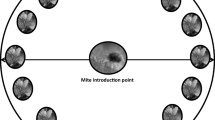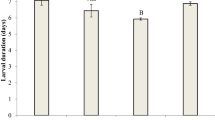Abstract
Cucurbitacins are bitter triterpenoid compounds that are toxic to most organisms and occur widely in wild and cultivated Cucurbitaceae. The only cucurbitacin identified in Cucumis sativus is cucurbitacin C. The bitter taste of cucumber has been correlated with resistance to the spider mite Tetranychus urticae, but a quantitative relationship has not been established. We determined the spider mite resistance and cucurbitacin C content in the dihaploid progeny derived from the F1 generation of a cross between a bitter, spider-mite-resistant cucumber line and a bitter-free, spider-mite-susceptible line. The ratio of the number of bitter to bitter-free dihaploids conformed to the expected 1:1 ratio, based on a monogenic segregation pattern. Genetic analysis ascribed 69% of the variance of the difference in spider mite survival rate to the bitterness locus. Within the group of bitter dihaploids, cucurbitacin C content was significantly correlated with spider mite resistance. Thus, a quantitative relationship between cucurbitacin C content and spider mite resistance could be established.
Similar content being viewed by others
References
Agrawal, A. A. 2000. Host range evolution: adaptation and trade-offs in fitness of mites on alternative hosts. Ecology 81:500-508.
Agrawal, A. A., Gorski, P. M., and Tallamy, D.W. 1999. Polymorphism in plant defense against herbivory: Constitutive and induced resistance in Cucumis sativus. J. Chem. Ecol. 25:2285-2304.
Andeweg, J. M. and De Bruyn, J. W. 1959. Breeding of non-bitter cucumbers. Euphytica 8:13-20.
Balkema-Boomstra, A. G., Zijlstra, S., and Van Der Helm, F. 1999. A rapid method to test resistance to spidermite (Tetranychus urticae) in cucumber. IOBC/WPRS Bull. 22:9-12.
Bar-Nun, N. and Mayer, A. M., 1989. Cucurbitacins protect cucumber tissue against infection by Botrytis cinerea. Phytochemistry 28:1369-1371.
Bouwmeester, H. J., Verstappen, F. W. A., Posthumus, M. A., and, Dicke, M. 1999. Spidermite-induced (3S)-(E)-nerolidol synthase activity in cucumber and lima bean. The dedicated step in acyclic C11-homoterpene biosynthesis. Plant Physiol. 121:173-180.
Crow, J. F. 1967. Genetics Notes, 6th ed. Burgess Publishing Company, Minneapolis, 226 pp.
Da Costa, C. P. and Jones, C. M. 1971a. Cucumber beetle resistance and mite susceptibility controlled by the bitter gene in Cucumis sativus L. Science 172:1145-1146.
Da Costa, C. P. and Jones, C. M. 1971b. Resistance in cucumber, Cucumis sativus L. to three species of cucumber beetles. HortScience 6:340-342.
Degenhardt, J. and Gershenzon, J. 2000. Demonstration and characterization of (E)-nerolidol synthase from maize: A herbivore-inducible terpene synthase participating in (3E)-4,8-dimethyl-1,3,7-nonatriene biosynthesis. Planta 210:815-822.
Dinan, L., Whiting, P., Girault, J. P., Lafont, R., Dhadialla, T. S., Cress, D. E., Mugat, B., Antoniewski, C., and Lepesant, J. A. 1997. Cucurbitacins are insect steroid hormone antagonists acting at the ecdysteroid receptor. Biochem. J. 327:643-650.
Ferguson, J. E., and Metcalf, R. L. 1985. Cucurbitacins: plant-derived defense compounds for diabroticites (Coleoptera: Chrysomelidae). J. Chem. Ecol. 11:311-318.
Ferguson, J. E., Metcalf, E. R., Metcalf, R. L., and Rhodes, A. M. 1983. Influence of cucurbitacin content in cotyledons of cucurbitaceae cultivars upon feeding behaviour of Diabrotica beetles (Coleoptera: Chrysomelidae). J. Econ. Entomol. 75:47-51.
Genstat 2001. 5th ed. release 4.21. Lawes Agricultural Trust, Rothamsted Experimental Station, UK.
Gershenzon, 1994. The cost of plant chemical defense against herbivory: a biochemical perspective. pp. 105-173, in E. A. Bernays (ed.). Insect-Plant Interactions, Vol. V. CRC Press, Boca Raton, Florida.
Gorski, P. M., Jaworski, A., Shannon, S., and Robinson, R. W. 1986. Rapid TLC and HPLC quantification of cucurbitacin C in cucumber cotyledons. HortScience 21:1034-1036.
Gould, F. 1978. Resistance of cucumber varieties to Tetranychus urticae: genetic and environmental determinants. J. Econ. Entom. 71:680-683.
Haynes, R. L. and Jones, C. M. 1975. Wilting and damage to cucumber by spotted and stripes cucumber beetles. HortScience 10:266-266.
Kooistra, E. 1971. Red spidermite tolerance in cucumber. Euphytica 20:47-50.
Mirò, M. 1995. Cucurbitacins and their pharmacological effects. Phytother. Res. 9:159-168.
NishidaR. and Fukami, H. 1990. Sequestration of distasteful compounds by some pharmacophagous insects. J. Chem. Ecol. 16:1519-1522.
Pierce, L. K. and Wehner, T. C. 1990. Review of genes and linkage groups in cucumber. HortScience 25:605-615.
Ponti, O. M. B. de 1978. Resistance in Cucumis sativus L. to Tetranychus urticae Koch. 4. The genuineness of the resistance. Euphytica 27:435-439.
Ponti, O. M. B. de and Garretsen, F. 1980. Resistance in Cucumis sativus L. to Tetranychus urticae Koch. 7. The inheritance of resistance and bitterness and the relation between these characters. Euphytica 29:513-523.
Rice, C. A., Rymal, K. S., Chambliss, O. L., and Johnson, F. A. 1981. Chromatographic and mass spectral analysis of cucurbitacin of three Cucumis sativus cultivars. J. Agric. Food Chem. 29:194-196.
Tallamy, D. W. and Gorski, P. M. 1997. Long-and short-term effect of cucurbitacin consumption on Acalymma vittatum (Coleoptera: Chrysomelidae) fitness. Environ. Entomol. 26:672-677.
Wehner, T. C., Liu, J. S., and Staub, J. E. 1998. Two-gene interaction and linkage for bitterfree foliage in cucumber. J. Am. Soc. Hortic. Sci. 123:401-403.
Author information
Authors and Affiliations
Corresponding author
Rights and permissions
About this article
Cite this article
Balkema-Boomstra, A.G., Zijlstra, S., Verstappen, F.W.A. et al. Role of Cucurbitacin C in Resistance to Spider Mite (Tetranychus urticae) in Cucumber (Cucumis sativus L.). J Chem Ecol 29, 225–235 (2003). https://doi.org/10.1023/A:1021945101308
Issue Date:
DOI: https://doi.org/10.1023/A:1021945101308




